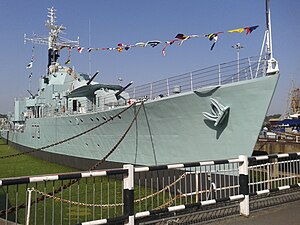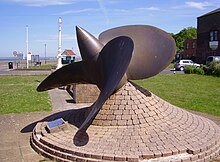HMSCavalier(R73)
This articleneeds additional citations forverification.(August 2007) |
 HMSCavalier,September 2023, as she appears atChatham Dockyard.
| |
| History | |
|---|---|
| Name | HMSCavalier |
| Builder | J. Samuel Whiteand Company,Cowes,Isle of Wight |
| Laid down | 28 March 1943 |
| Launched | 7 April 1944 |
| Commissioned | 22 November 1944 |
| Decommissioned | 1972 |
| Identification | Pennant number:R73 (later D73) |
| Motto | "Of one Company" |
| Fate | Sold 21 October 1977. |
| Status | Preserved as amuseum shipsince 1998 |
| General characteristics | |
| Class and type | C-classdestroyer |
| Displacement | 1,710 tons (standard) 2,520 tons (full) |
| Length | 363 ft (111 m)o/a |
| Beam | 35.75 ft (10.90 m) |
| Draught | |
| Propulsion |
|
| Speed | 37 knots (69 km/h) |
| Range | 615 tons oil, 1,400 nautical miles (2,600 km) at 32 knots (59 km/h) |
| Complement | 186[1] |
| Armament |
|
HMSCavalieris a retiredC-classdestroyerof theRoyal Navy.She was laid down byJ. Samuel Whiteand Company atEast Coweson 28 March 1943, launched on 7 April 1944,[1]and commissioned on 22 November 1944.[3]She served inWorld War IIand in various commissions in theFar Eastuntil she was decommissioned in 1972. After decommissioning she was preserved as a museum ship and currently resides atChatham Historic Dockyard.[4]
Construction[edit]
Cavalierwas one of 96War Emergency Programme destroyersordered between 1940 and 1942. She was one of the first ships to be built with the forward and aft portions of her hull welded, with the midsectionrivetedto ensure strength. The new process gave the ship additional speed. In 1970 a 64-mile race was arranged betweenCavalierand the frigateRapid,which had the same hull form and machinery.CavalierbeatRapidby 30 yards (27 m) afterRapidlifted asafety valve,reaching an average speed of 31.8 knots (58.9 km/h).[2]
Service history[edit]
After commissioning, she joined the6th Destroyer Flotilla,part of theHome Fleet,and took part in a number of operations offNorway.Most notably in February 1945 she was despatched with the destroyersMyngsandScorpion[5]to reinforce a convoy from theKola InletinRussia,which had suffered attacks from enemy aircraft andU-boats,and had subsequently been scattered by a violent storm. She and the other escorts reformed the convoy, and returned to Britain with the loss of only three of the 34 ships. This action earnedCavalierabattle honour.[3]
Later in 1945,Cavalierwas despatched to the Far East, where she provided naval gunfire support during theBattle of Surabaya.In February 1946, she went toBombayto help quell theRoyal Indian Navy Mutiny.After some time in theBritish Pacific Fleetshe was paid off in May 1946 and was placed in reserve atPortsmouth.[5]
From 1955 to 1957,Cavalierwas modernised atThornycroft'sWoolston, Southamptonshipyard, removing some of her torpedo tubes and a 4.5-inch gun in favour of twoSquidanti-submarine mortars.[6][7]She recommissioned on 16 June 1957, replacingComusin the 8th Destroyer Squadron inSingapore.[6][8]From March to April 1958,Cavaliertook part in theOperation Grapple,the British nuclear weapon tests atMalden IslandandKiritimati.[6]In August 1959,Cavalierwas ordered to the important RAF base atGan Islandin theMaldivesin response to civil unrest, remaining there until relieved by sister shipCapriceon 29 August.[9]In December 1962, she transported 180 troops from Singapore toBruneito help suppress a rebellion that became part of theIndonesia-Malaysia Confrontation.After disembarking the troops she remained in Brunei as a communications centre for several days until other Royal Navy ships arrived to relieve her.[10][11]On 21 May 1964,Cavalierwas being towed by the tug RFARewardtoGibraltarfor refit when she was in collision with the Liberian tankerBurgan,about 35 nmi (40 mi; 65 km) south-west ofBrighton.Cavalier's bows were badly damaged, while one ofBurgan's crew suffered head injuries and had to be airlifted to hospital.[12][13]Cavalierunderwent temporary repairs atPortsmouthbefore being fitted with a new bow atDevonport.She finally underwent the planned refit at Gibraltar from August 1964 to April 1966.[12]
On 6 July 1971,Cavalierparticipated in a race against a similar ship,HMSRapid.Cavaliernarrowly won the race after a safety valve blew onRapid.Cavalierwas presented with the 'Cock o' the Fleet' award. The award can be seen on the ship's bridge to this day.[14][15]
Cavalierwas decommissioned in 1972 and is the last surviving British destroyer of World War 2 still in the UK.
Fate[edit]
After decommissioning atChatham Dockyard,she was laid up inPortsmouth.As a unique survivor, after a five-year campaign led byLord Louis Mountbatten,the ship was purchased by the Cavalier Trust for £65,000 and handed over onTrafalgar Day1977 in Portsmouth. By selling the ship to the trust, the UK government and the Royal Navy severed all formal connection and responsibility for the ship. A special warrant was issued that allows her to retain the prefix "HMS" (His Majesty's Ship) and fly theWhite Ensign,a privilege normally only enjoyed by commissioned ships of the Royal Navy. A similar privilege is enjoyed by another museum ship, the cruiserBelfast.
Moved toSouthampton,Cavalieropened as a museum and memorial ship in August 1982. This was not commercially successful, and in October 1983 the ship was moved toBrighton,where she formed the centrepiece of a newly built yacht marina.

In 1987, the ship was brought to theRiver Tyneto form the main attraction of a national shipbuilding exhibition centre planned bySouth Tyneside Metropolitan Borough Councilin the former shipyard ofHawthorn Leslie and Company,builders of many similar destroyers. The plans for the museum came to nothing, and the borough council, faced with annual maintenance costs of £30,000 and a hardening of public opinion against unnecessary expenditure, resolved to sell the ship and wind up the venture in 1996. The ship sat in a dry dock (owing to a previous list) in a rusting condition, awaiting a buyer or scrapping in situ.
After the reforming of the Cavalier Trust, and a debate in Parliament, in 1998Cavalierwas bought byChatham Historic Dockyardfor display as a museum ship. Arriving on 23 May 1998,Cavaliernow resides in No. 2 dry-dock.
On 14 November 2007,Cavalierwas officially designated as a war memorial to the 142 Royal Navy destroyers sunk during World War II and the 11,000 men killed on those ships. The unveiling of a bronze monument created by the artist Kenneth Potts was conducted byPrince Philip, Duke of Edinburgh.The monument is adjacent to the ship at the Historic Dockyard in Chatham, Kent.
In the summer of 2009 the Chatham Historic Dockyard Trust made available accommodation on board the ship for youth groups who wish to stay on board and experience life on board a Royal Naval destroyer.
In September 2010,Cavalierfired the first full broadside from a ship flying the White Ensign since a firing by the destroyerLondonin December 1981. This was due to the work of the heritage naval gun crew who restored all three 4.5-in guns back to working condition in conjunction with the Chatham Historic Dockyard Trust.
In April 2014Cavalierwas added toGoogle Maps Business View(formerlyGoogle Business Photos)[16]in celebration of the 70th anniversary of her launch.[17][18]The tour, which includesCavalier's engine and gear room, was enhanced with interactive audio hotspots to enable visitors with accessibility issues to explore the ship.[19]
Gallery[edit]
-
Cavalierin 2014
-
Navigation bridge
-
Forward 4.5in guns
-
Operations room
-
Seacat launcher
-
Seaman's mess
-
Ship's bell
-
The grog tub
References[edit]
- ^abcdMcMurtrie 1989,p. 52
- ^abcd"Cavaliers Specifications".HMS Cavalier Association.Retrieved22 May2015.
- ^ab"HMS Cavalier (R 73)".uboat.net.Retrieved22 May2015.
- ^"HMS Cavalier".National Register of Historic Vessels.National Historic Ships.Retrieved22 May2015.
- ^abcEnglish 2008,p. 122
- ^Marriott 1989,pp. 58–59
- ^Marriott 1989,p. 59
- ^Roberts 2009,p. 23
- ^David Davies Lt. Cdr. Rtd Royal Navy/Royal New Zealand Navy."The Laughing Cavalier in Borneo".Britain's Small Wars. Archived fromthe originalon 14 September 2008.Retrieved25 April2009.
- ^"Royal Marines killed in Brunei"(PDF).Navy News.January 1963. p. 1.Retrieved2 September2020.
- ^abEnglish 2008,p. 123
- ^"Cavalier damaged on tow to Gibraltar"(PDF).Navy News.June 1964. p. 3.Retrieved31 May2021.
- ^World of Warships Official Channel (22 September 2017),Naval Legends: HMS Cavalier | World of Warships],retrieved13 May2019
- ^Johnstone-Bryden, Richard (30 July 2015).HMS Cavalier Destroyer 1944.Seaforth Publishing.ISBN9781848323759.
- ^"Business View".Retrieved20 April2014.
- ^"HMS Cavalier – Google Maps Business View".cinsidemedia.com. Archived fromthe originalon 20 April 2014.Retrieved20 April2014.
- ^"HMS Cavalier – Google Maps".Retrieved20 April2014.
- ^"The Historic Dockyard Chatham – HMS Cavalier Virtual Tour".thedockyard.co.uk. Archived fromthe originalon 21 April 2014.Retrieved20 April2014.
Publications[edit]
- Colledge, J. J.;Warlow, Ben (2006) [1969].Ships of the Royal Navy: The Complete Record of all Fighting Ships of the Royal Navy(Rev. ed.). London: Chatham Publishing.ISBN978-1-86176-281-8.
- English, John (2008).Obdurate to Daring: British Fleet Destroyers 1941–45.Windsor, UK: World Ship Society.ISBN978-0-9560769-0-8.
- Marriott, Leo (1989).Royal Navy Destroyers Since 1945.Ian Allan Ltd.ISBN0-7110-1817-0.
- McMurtrie, Francis E., ed. (1989).Jane's Fighting Ships of World War II.Crescent Books/Random House.ISBN0-51767-963-9.
- Roberts, John (2009).Safeguarding the Nation: The Story of the Modern Royal Navy.Annapolis, Maryland, USA: Naval Institute Press.ISBN978-1-59114-812-8.
- Johnstone-Bryden, Richard (2015).HMS Cavalier: Destroyer 1944.Seaforth Publishing.ISBN978-1-84832-226-4.
- David L. Williams, Richard P. De Kerbrech (2012).J. Samuel White and Co., Shipbuilders.History Press Limited.ISBN978-0-75246-612-5.
External links[edit]
- HMSCavalier(R73)at Historic Naval Ships Association
- Chatham Historic Dockyard
- HMSCavalierAssociation








